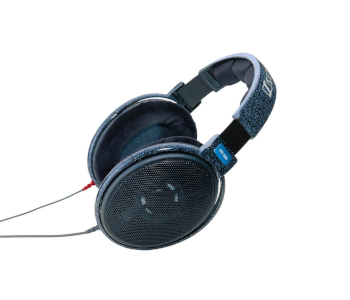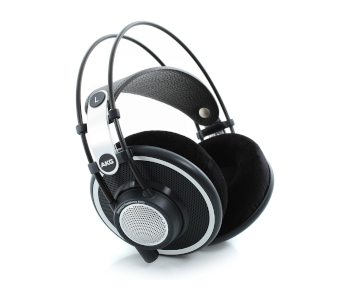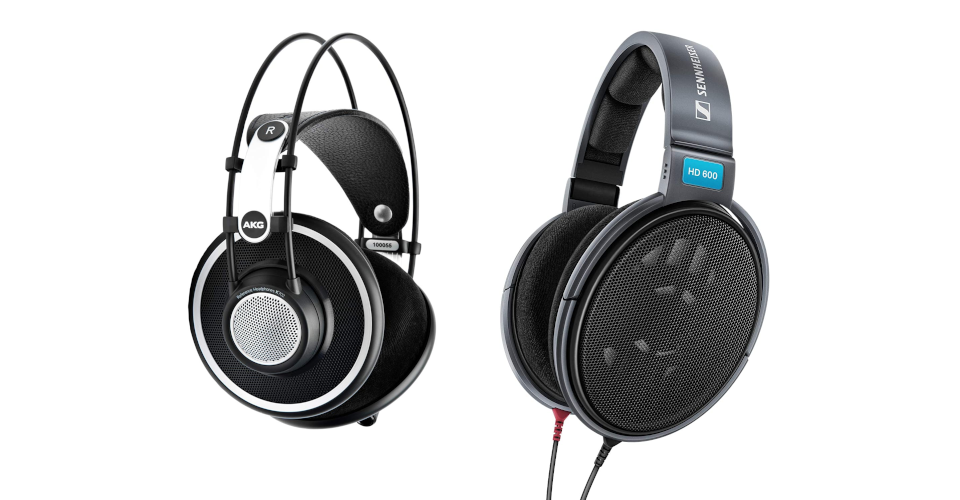Headphones Comparison: Sennheiser HD 600 vs. AKG K702
The Sennheiser HD 600 and the AKG K702 are two of the best open-back headphones under $500, with the former being one of the most popular headphones among audiophiles and headphone enthusiasts. Both are good headphones for listening to music at home and for studio use. Although they sound different, they are similar in many other aspects, including sound isolation and connectivity options.
When choosing between the two headphones, you’ll most likely make your decision based on the sound profile, but it’s still worth considering the other things that separate them. With this head-to-head comparison article, we’ll help you make a more informed decision in the end by giving you a detailed look at the differences and similarities between the HD 600 and the K702.
Quick Look
| Sennheiser HD 600 | AKG K702 | |
|---|---|---|
| Type | Wired over-ear | Wired over-ear |
| Enclosure | Open-back | Open-back |
| ANC | No | No |
| Connectivity | 1/8 in (3.5 mm) analog, 1/4 in (6.3 mm) adapter | 1/8 in (3.5 mm) analog, 1/4 in (6.3 mm) adapter |
| Battery | N/A | N/A |
| Weight | 9.2 oz | 8.3 oz |
| Price | Amazon | Amazon |
Design
The HD 600 and the K702 are similar in several design aspects. They belong in the same headphone category and have the same accessories and cable length and connector. Both have mediocre portability and lack controls for music management. Their main differences lie in the fit and build categories, but neither has a substantial advantage over the other in both of those areas.
Many people will find the AKG headphones more comfortable due to their looser fit, but they are less stable on the head. They have a more complicated structure that makes them less mod-friendly, not to mention their spare parts are harder to find. On the other hand, the Sennheiser headphones have a much tighter fit that negatively affects their overall comfort, but their stability is better. In addition to being easier to modify and repair, their spare parts are also more readily available.
Fit
Similarly featuring open ear cups with grilles on the backplates, the HD 600 and the K702 are both over-ear headphones with bulky but lightweight frames. Their ear cups are similarly large and spacious and have thick, velour-covered cushions that feel more luxurious than leather earpads. With their open-back ear cups, they are more breathable than closed-back headphones, which is beneficial for long listening sessions.
In addition to their different ear cup shapes – oval for the HD 600 and circular for the K702 – the two headphones have noticeably different headband designs. The Sennheiser headphones have a typical, padded headband with a metal slider for the manual adjustment mechanism while the AKG headphones feature a self-adjusting headband composed of a flexible outer arc and an inner strap.
While their bulkier frame might suggest otherwise, the K702 are more comfortable than the HD 600, making them more suitable for long listening sessions, especially in a studio setting. This is because of their looser headband fit, which is especially beneficial if you have a large head. On the other hand, the looser clamp hurts the stability of the headphones, causing them to slide off more easily.
The HD 600 are the exact opposite of the K702. They have a very tight headband clamp, especially out of the box. Many people still find them comfortable, with their tight fit hardly being an issue, but they are more fatiguing on the head during long listening sessions. Their thick earpads help mitigate the tight clamp, but not by a considerable amount. On the bright side, their tight fit allows for much better stability than the AKG headphones. They stay securely on your head and don’t easily slide forward or backward when moving around.
Build

The build qualities of the two headphones are similarly solid, with their mostly plastic builds appearing sturdy and durable, but there are better-built headphones in the same price range. Their straight audio cables – which both measure around 10 feet long and end with 1/8 in (3.5 mm) analog plugs – are detachable, which adds to their overall durability.
Featuring a Kevlar-reinforced audio cable that connects to both ear cups, the HD 600 are the heavier headphones, but not by much. Their ear cups, which have metal grilles, are sturdy, but their metal-reinforced plastic headband feels rather fragile. Compared to the K702, they are easier to disassemble, modify, and repair, with more easily accessible spare parts. You can easily find replacement parts for the entire headband module, for example.
The K702, which have a retro aesthetic that some will find unappealing, include an audio cable that connects to the left ear cup instead of both sides. Their outer headband arc is flexible and easily adjusts to large heads while their inner strap is made of genuine leather that feels nice on the head. You can also modify them to alter their fit and sound profile, but they have a more complicated structure and are not as easy to disassemble as the Sennheiser headphones, not to mention spare parts are harder to find.
Although both headphones are similarly well-built, the HD 600 have a slight edge here. In addition to their more durable audio cable, they have a more straightforward structure, with fewer moving parts, and are easier to modify and repair. Their spare parts are more readily available as well, making it easier to extend their lifespan.
Controls
Like other audiophile and professional headphones, both the HD 600 and the K702 lack any form of controls. Their ear cups lack onboard controls while their audio cables lack an in-line remote for music management. This is hardly a deal-breaker, though, as both headphones are not designed for listening to music while on the go, where having an in-line remote is more convenient. If you really want an in-line remote (with or without a built-in mic for calls), you can look into third-party audio cables that are compatible with the headphones.
Portability
With their bulky and non-foldable designs, the HD 600 and the K702 are both mediocre in this category, which can also be said for many other similarly designed headphones. In addition to their non-foldable designs, their ear cups don’t rotate to a flat position to make them a bit easier to slip into your backpack.
Both headphones also lack any form of storage such as a hard case or drawstring pouch, which may disappoint some people since there are less expensive products that include at least a soft pouch. You can use the boxes of both headphones as storage when not in use or when carrying them to another place. But while their boxes provide protection against dust, scratches, and minor physical impact, they don’t add to their portability since they are also bulky and will take up a lot of space in your bag.
The mediocre portability of both the HD 600 and the K702 shouldn’t be a big issue, especially if you intend to use them primarily for listening to music at home or for sound mastering and mixing in the studio. However, if you want to use them for listening to music in the office – assuming you have your own room and won’t bother other people with high sound leakage – their mediocre portability is something you should keep in mind.
Accessories
For both headphones, the only item included in the box aside from the audio cable and the documentation is a 1/4 in (6.3 mm) stereo jack adapter, which is normally included with audiophile and professional headphones. There are no extra earpads, shorter audio cable for mobile use, or case included.
The lack of a shorter mobile cable is not really surprising for headphones designed for studio and home use, but the lack of a case or pouch for storage is a bit disappointing for products normally selling for around $300. As mentioned in the previous category, you can use the boxes of both headphones as a makeshift case to protect them against dust and physical impact when not in use.
The stereo jack adapters of the two headphones are not the same. For the AKG headphones, the adapter is the more commonly seen screw-on type. For the Sennheiser headphones, the adapter is a snap-on type that makes it seem like the audio cable ends with a 1/4 in (6.3 mm) analog plug by default.
Performance
Like in the design section, the HD 600 and the K702 are similar in most categories in this section, with no clear winner between them. Since both headphones lack a mic and battery-powered features, they are tied in the mic and battery categories. Both also have mediocre sound isolation (noise isolation and sound leakage) and are very limited in connectivity options and features. The one area where they are markedly different is in audio reproduction.
Sound
While the HD 600 and the K702 are practically identical in all other performance aspects, they take different paths in this category. Both headphones are some of the best-sounding in their respective price ranges, but you’ll need a decent amp for the best results. They similarly sound clean and detailed and have good instrument separation, though their sound profiles are different.
The Sennheiser headphones have more bass impact and presence while the AKG headphones have a more accurate bass, but the two headphones are similarly lacking in bass overall, which fans of hip hop and electronic dance music will find unappealing. On the opposite end, the HD 600 have a smoother, more accurate, and better-balanced treble.
Both headphones have a rich, natural, and magnificently detailed mid-range, with clear and balanced reproduction of vocals and instruments. Regarding soundstage, the AKG headphones have a wider and more airy soundstage that can be compared to listening to speakers while the Sennheiser headphones have a narrower but more intimate soundstage that some people will prefer.
Overall, the HD 600 have a warmer, more musical, more intimate, and more engaging sound signature that makes them better for purely listening to music at home. They are more all-around headphones that are suitable for most music genres. On the other hand, the K702 have a more immersive, more open, more analytical, and more honest sound. In addition to being good for listening to music, they are better for gaming and watching movies than the Sennheiser headphones, with their wider soundstage being especially useful for the former.
Although the HD 600 are also good for professional studio use, the K702 are better at revealing flaws in the recording, making them more suitable for critical listening. However, many people will also find them boring and not as enjoyable for music as the HD 600 due to their clinical sound, which can also be said for many other neutral-sounding headphones.
Isolation

Considering their open-back designs, poor passive noise isolation and high sound leakage are a given for both the HD 600 and the K702. Their practically non-existent noise isolation hurts their overall versatility and makes them unsuitable for listening to music in noisy environments. Meanwhile, their high sound leakage means you’ll disturb people around you even with the volume set to moderate or low levels.
Whether for critical listening, enjoying music, gaming, or watching movies, both headphones are best used in a quiet environment where there are no other people around to bother with their high sound leakage. They are not suitable for listening to music while traveling or commuting. You can use them in the office if you don’t mind their portability issues, but only if their high sound leakage is not going to be a problem.
Since their sound leakage is high – especially with the Sennheiser headphones – the HD 600 and the K702 are also not recommended headphones for recording tracks in the studio. The sound leakage from the live feedback will be picked up by your mic, ruining the recording. Closed-back headphones are much better options if you want to monitor yourself and keep the sound leakage low to prevent it from bleeding into the mic.
Mic
Speaking of mics, both headphones lack one. This is not an issue when using the headphones for listening to music at home and in the studio. If you plan to use them for gaming and prefer having a boom mic for voice chat when playing multiplayer games, you’ll need to modify them. It’s easier if you simply want a mic for phone calls, though: You can purchase a third-party audio cable with an in-line mic and remote.
Battery
There is no need to worry about battery performance for both headphones. They are completely passive headphones with no battery-powered features. This means you can use them as much as you want without worrying about running out of battery and having to recharge them.
Connectivity
The HD 600 and the K702 are identical in this category, with both of them offering (and lacking) the same connectivity options and features. They are limited to wired connectivity, with their audio cables ending with 1/8 in (3.5 mm) analog plugs, which allow for compatibility with pretty much any device that includes a regular headphone port.
You can connect them to smartphones, computers, and portable music players. You can also connect them to gaming consoles – either directly for handheld consoles or through the headphone port on compatible wireless controllers for PS4 and Xbox One consoles. The 1/4 in (6.3 mm) plug adapters included with both headphones are used for connecting with different audio equipment when using the headphones in a studio setting.
While not as convenient as wireless connectivity, the regular wired connections of both headphones eliminate latency issues. This is especially beneficial when using the headphones for gaming and for watching video content on the internet. The audio cables of the two headphones both measure around 10 feet long, allowing for more freedom of movement, especially in the studio. As mentioned, the audio cables are straight instead of coiled and are detachable, making them easy to replace when damaged.
Wrap-up
| Sennheiser HD 600 | |
|---|---|
| Despite being around for many years, the HD 600 are still some of the best and most popular open-back headphones on the market. They are great-sounding headphones that are suitable for most music genres and are easy to repair and modify, with easily accessible spare parts. While their soundstage is narrow, their musical, intimate, engaging sound makes them a delight to use purely for listening to music at home. Their build quality is also good, with durable ear cups featuring metal grilles, but their headband is a notable weakness – it feels rather fragile and has a very tight clamp that many people will find uncomfortable for extended listening. Overall, the HD 600 are an excellent pair of open-back headphones. If you prefer headphones that are more all-around for listening to music and are easier to disassemble and tinker with, they are a better option than the K702. | |
| Pros | Cons |
|
|
| AKG K702 | |
|---|---|
| The K702 are versatile open-back headphones that sound great and are very comfortable to wear for long hours. While they are marketed specifically as studio headphones, they are also good for simply listening to music at home and for gaming and watching movies. Their neutral and clinical sound is beneficial for studio use while their wide soundstage is useful for gaming, especially if you love to play first-person shooter games. Compared to the HD 600, they have a more analytical sound that makes them better-suited for finding flaws in the recording. They are also more comfortable to wear for long hours, whether at home or in the studio, mainly due to their looser fit. On the other hand, their colder sound is not for everyone while their looser headband clamp causes them to slide off from your head more easily. All in all, if you prefer versatile headphones that are suitable for listening to music, studio use, gaming, and watching movies, get the K702 instead of the Sennheiser headphones. | |
| Pros | Cons |
|
|

